| |
|


FRIDAY, JULY 18 Temple Solel Shabbat at Beach
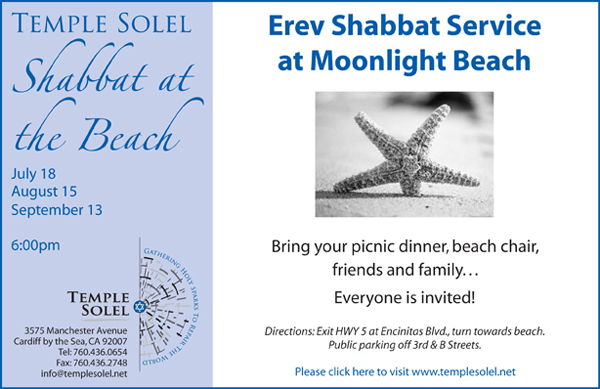

SATURDAY, AUGUST 2 Temple Emanu-El Joshua Nelson Concert


MON., SEPT. 29-THURS., OCT. 9



FROM THE GATES OF THE NEGEV
San Diego's UJF Mission arrives in Sha'ar Hanegev; where else to go for Latin food?
By Ulla Hadar
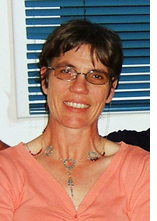 KIBBUTZ OR HANER, Israel—Living close to the Mexican border, San Diegans know a thing or two about good Latin food. So, of course, they came to the Sha’ar Hanegev region of Israel to Kibbutz Or Haner. Most of the kibbutz’s members hail originally from Argentina, which perhaps explains why the farming community is so highly regarded for its Argentinian food, particularly its beef. KIBBUTZ OR HANER, Israel—Living close to the Mexican border, San Diegans know a thing or two about good Latin food. So, of course, they came to the Sha’ar Hanegev region of Israel to Kibbutz Or Haner. Most of the kibbutz’s members hail originally from Argentina, which perhaps explains why the farming community is so highly regarded for its Argentinian food, particularly its beef.
After a day of learning and touring at the nearby student village of Ibim, the San Diegans were more than ready for a traditional Argentinian asado dinner in the local “Patagonia’ restaurant.
Spanish-speaking Israelis? In fact, the 75 members of a family mission sponsored by the United Jewish Federation of San Diego could have heard many languages in addition to Hebrew and English during their visit to Ibim, Or Haner and their polyglot environs. Among Ibim activities from which mission members, including 29 minors, could choose was making ingina, a spongy Ethiopian bread, under the expert direction of Amharic-speaking Jews from Ethiopia.
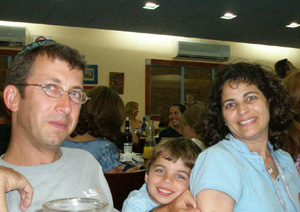 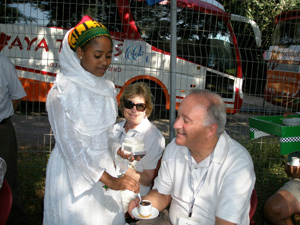
Ibim, a village for 400 student immigrants who travel to Israel in advance of their parents, also has many Russian-speakers as well as other Jews who know the languages of some of the other former Soviet Republics.
Other activities in Ibim from which mission participants could choose included making handicrafts or checking out and adding to the graffiti inside the bomb shelters in this area close to the Gaza border. Until the recent shaky ceasefire with Hamas, Ibim residents regularly ducked into the shelters whenever they heard the “red alert” warning announcing incoming Kassam missiles.
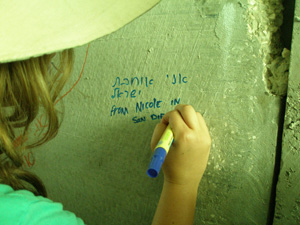 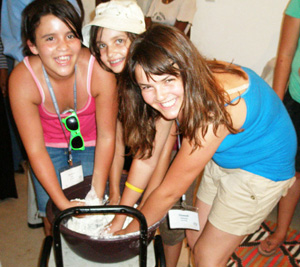
Sony Zinger, the village’s director, welcomed the mission participants, thanking them and the United Jewish Federation for the special relationship Ibim enjoys with San Diego. From 1998 to 2008, under an initial ten-year contract, San Diego contributed $750,000 annually for the upkeep of the student village. Recently the Federation’s board voted to extend that partnership by three years, which will take the Ibim-San Diego relationship to its 13th or bar mitzvah year.
Moshe Vigdor, director-general of the Jewish Agency for Israel, has spoken in high praise of the San Diego-Ibim relationship, saying that it not only is important in the absorption process of immigrant students but also serves as a catalyst for the growth of the Sha’ar Hanegev region. It creates a steady infusion of potential settlers in the population-starved Negev.
At Or Haner, the youngsters on the mission were delighted to swim in the kibbutz swimming pool with children their own ages, while the adults went to the maodon (clubhouse) for a concluding meeting.
I had a chance to catch UJF director Michael J. Rassler for an interview. "The trip has been incredible,” he said. Participants include “quite a number of families including three generations, and many first timers to Israel. The participants have expressed to me how incredible the experience and the trip has been. When we had a chance to reflect and look back on what we have been doing, several even mentioned doing aliyah.”
Because of the closeness to the Gaza border, Rassler said, “for many coming to Sha’ar Hanegev was something they were very concerned about. … Friends and family wanted to know why we were so "meshugenah" wanting to go to Israel. But coming to Israel and feeling, tasting, touching, experiencing the sights and sounds of Israel is more than visiting the archaeological, historic and religious sites, it is about meeting the people.
“And in Sha’ar Hanegev, it is a really true encounter,” Rassler continued. “For me personally my heart is here. I literally feel that I have family here. To bring people for the first time here and to share with them the relationship, the partnership, the friendship, hospitality and warmth--in a sense we are one family.
“Many of the Jewish community in San Diego know what the Federation does in San Diego but have no idea what is the other half that we deal with--here in terms of Israel and around the world.”
Rassler said that scheduling a family mission for participants ranging in age from 6 to 80 required considerable imagination. “It shows what a labor of love it was when you see the first-time experience in their eyes, and you are able to make the connection real."
Before arriving to Sha’ar Hanegev the San Diegans visited several places in Israel. In Tel Aviv they saw the Diaspora and Palmach museums; in the North they rafted on the Jordan river and toured the Golan Heights, explored the remnants of the old port of Caesarea and tasted Jewish mysticism in Tsfat. They also visited the Ein Gedi nature reserve, climbed Masada and floated in the Dead Sea plus experiencing Jerusalem including a visit to the Western Wall.
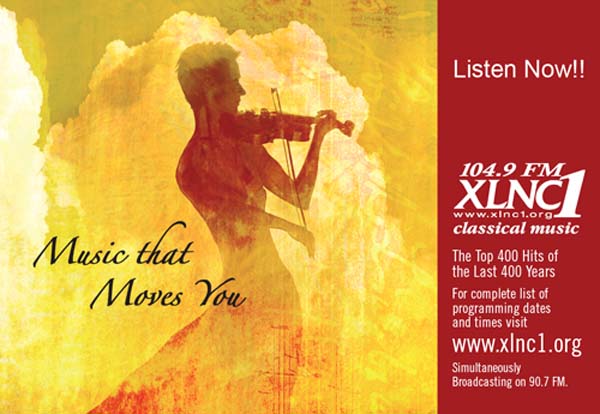

FROM THE SIDELINES
Involving neo-Nazi youths in research
led to turnaround in their attitudes
By Rabbi Dow Marmur
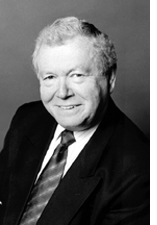 TORONTO, Canada--Sweden, where I spent nine formative years of my life, is famous for its laudable commitment to openness and individual freedom. It shares with Canada not only much of landscape and climate but also many of the values that make for civil society. The price, however, that Sweden has had to pay for promoting liberty is that extremists, including racists in general and anti-Semites in particular, have taken advantage of it and flourished with impunity. TORONTO, Canada--Sweden, where I spent nine formative years of my life, is famous for its laudable commitment to openness and individual freedom. It shares with Canada not only much of landscape and climate but also many of the values that make for civil society. The price, however, that Sweden has had to pay for promoting liberty is that extremists, including racists in general and anti-Semites in particular, have taken advantage of it and flourished with impunity.
Even during World War II, for all of Sweden's formal neutrality, some of its citizens were Nazis and many more were fellow-travellers. Afterward, anti-Semites, in their relentless effort to infest the world, spread their poison from Swedish addresses. Still today, neo-Nazi gangs thrive in the land.
But Sweden, like Canada, is also known for its humanitarian work. Thanks to his legendary efforts while serving in the Swedish embassy in Budapest, Raoul Wallenberg saved many thousands of Hungarian Jews from being sent to the gas chambers by the Nazis. Some of the survivors settled in Canada after the war.
In the same vein, in the last weeks of the Nazi regime the Swedish Red Cross rescued thousands of Jewish women from German concentration camps. My wife, then age 9, was one of them. Some of these survivors also ended up in this country.
Aware of the yawning gap between menacing abuse of freedom and commitment to care for people in distress, Swedish educator Christer Mattsson has made it his mission to try to bridge it. Knowing that some of the women who were rescued by the Red Cross were so sick that they died upon arrival and that 16 of them were buried in his hometown Karlstad, Mattsson involved a group of teenagers, including gang members, in researching the history of the victims in the cemetery.
Finding out as much as possible about those who died, the group produced a 100-page report that its members recently delivered in person to the Yad Vashem Holocaust memorial in Jerusalem. In media interviews, some visitors told of their neo-Nazi backgrounds and how, having learned the truth about what happened to the 16 women and their 6 million fellow Jews, they have come to radically change their views away from error and prejudice.
We have much to learn from Mattsson. Instead of only inviting eyewitness survivors into his classroom, he engaged the young on a deeper and more creative level.
Though there are no Jewish graves in Canada like those in Karlstad, there are other graves, many as yet unmarked, particularly of the stolen children in Indian residential schools who never returned home. An effort to identify the victims and their descendants would reveal some of their history. The students would help turn the lofty words of the Prime Minister's formal apology and the expected findings of the Aboriginal Truth and Reconciliation Commission into acts of true healing.
The scope is enormous. The approach could also be used in relation to other minority groups.
Young Canadians would thus have their eyes and minds opened to what has been done and not done to some of those unable to speak for themselves.
Of course, no educational project, however imaginative, can in itself eradicate evil. But the kind of work that Mattsson has been doing may give his Canadian counterparts another tool in the continuous struggle against bigotry, hatred and ignorance that poison the minds of so many, especially the young, and thus potentially threaten the fabric of our society.


THE VIEW FROM JINSA
Sarkozy sacrifices Franch honor to Syria
By Shoshana Bryen
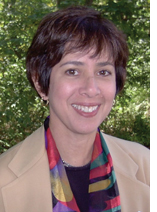 WASHINGTON, D.C, July 14—It is almost a shame to criticize French President Sarkozy on Bastille Day. But it is his own fault for feting Bashar Assad this week in Paris - at the expense of Lebanon, Israel and the French army, not to mention the United States and large parts of the Arab world. WASHINGTON, D.C, July 14—It is almost a shame to criticize French President Sarkozy on Bastille Day. But it is his own fault for feting Bashar Assad this week in Paris - at the expense of Lebanon, Israel and the French army, not to mention the United States and large parts of the Arab world.
Sarkozy claims a victory for inducing Syria and Lebanon to announce plans to establish embassies in one another's capitals - from the birth of Lebanon in 1943, Syria has maintained that it is simply an extension of Greater Syria, not a separate country. Claiming historic rights, Syria has stationed troops and intelligence officers in Lebanon, used the Bekka Valley for drug cultivation, chosen a long line of Lebanese presidents, and been the pathway for Iranian access. So isn't it good that Syria will now recognize Lebanon as an independent country?
No. The technicality of an embassy will only make it easier for Syria to run the parts of Lebanon it cares to run, like the government. The announcement was made at almost precisely the moment that Hezbollah was taking its unelected, violently assumed place in a new Lebanese cabinet, ensuring continued and deeper Iranian and Syrian control. And Hezbollah's "blocking third" in the new cabinet ensures that the UN probe of the murder of Rafik Harriri will find only dead ends. Surely this was not what France intended.
Sarkozy claimed victory for bringing Junior Assad and Prime Minister Olmert together. According to Reuters, "a Reuters photographer captured (Olmert) casting glances toward the Syrian leader. But Assad turned away, raising one hand to his face as if to block off any eye contact with the Israeli. It was the first time they had ever been in the same room together." Sarkozy and Reuters seem to think it is newsworthy when an Arab breathes the same air as an Israeli; we think it is disgusting that they think so.
Perhaps worst, Assad was an honored guest next to Sarkozy at the Bastille Day Parade, and, according to a German newspaper, the French government banned a planned protest by French veterans who blame Syria for the deaths of 58 French members of a UN peacekeeping force in Lebanon in 1983.
Sarko abased France - and Liberte, Egalite, Fraternite - by elevating a dictator who clearly has no interest in giving up his political, military and financial arrangements with Iran; who is violently repressive at home (where is the outrage over the killing of more than 100 inmates in a Syrian prison last week?); who was building a nuclear reactor with North Korea; who raped Lebanon and continues to allow Hezbollah to import arms into the south despite UN resolutions to the contrary; who rebuffed American friends in the region; and who harbors terrorists in Damascus and allows terrorists to infiltrate Iraq.
Assad let Sarko take him to the prom and show him off as a friend of France, if not the West. But Junior is hoping to go home with a different date. Assad's goal is to bring American attention and money to Syria - and maybe American pressure on Israel to cede the Golan Heights without a serious quid pro quo. Indeed, one longtime region-watcher said he was "auditioning for the next President." Surely that is not what France intended either, but that is what it got.


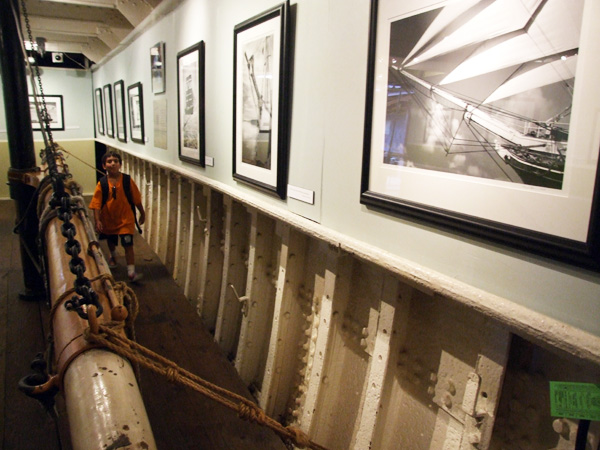
THE JEWISH CITIZEN
Jewish love for those great sailing ships
By Donald H. Harrison
 SAN DIEGO—If you put your ear to the hull of the Star of India in the gallery where Michael Berman’s photographs of tall ships are on display, you can hear tiny sounds--ping, ping, ping. According to exhibit designer Maggie Walton, the sounds from the waters outside are those of “the pistol shrimp—their claws are snapping, and it picks up the sound in the iron hull of this ship built in 1863.” SAN DIEGO—If you put your ear to the hull of the Star of India in the gallery where Michael Berman’s photographs of tall ships are on display, you can hear tiny sounds--ping, ping, ping. According to exhibit designer Maggie Walton, the sounds from the waters outside are those of “the pistol shrimp—their claws are snapping, and it picks up the sound in the iron hull of this ship built in 1863.”
You can get into see Berman’s photographs, such as the copyrighted one below showing the schooner California and the bowsprit of the Star of India, but the pistol shrimp are out of luck. The ship has remained seaworthy now for 145 years and if they want to see Berman’s photos, they’ll just have to pay the price of admission like everybody else.
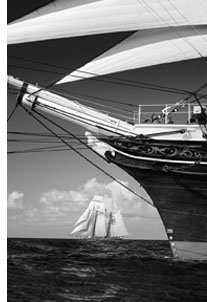 One of the things that Berman “likes about this exhibit is that it is a floating ship exhibit, an exhibit of ship portraits on the oldest sailing vessel in the world that still sails,” according to Walton. One of the things that Berman “likes about this exhibit is that it is a floating ship exhibit, an exhibit of ship portraits on the oldest sailing vessel in the world that still sails,” according to Walton.
The majesty of the Star of India has prompted Berman to travel from his home in Pt. Ludlow, Washington, to San Diego to be part of the photographic flotilla that participates in the Festival of Sail when the famed ship sails from the entrance of San Diego Bay at Point Loma back to its regular berth on Harbor Drive at the foot of Ash Street.
Berman’s photographs, says the appreciative Walton, help exemplify the art of nautical photography. “He gets in for some close ups and details, brings in a lot of action and drama, shows a lot of light and dark. He has detail, gracefulness, dark, light and greys, and drama.”
Getting a wonderful photograph of a ship –as Berman and such fellow Jews and predecessors in the field of nautical photography as Morris and Stanley Rosenfeld knew—is not simply a matter of waiting for the right shot to come along, and hoping your finger is on the shutter at the time. Rather it is a matter of aggressively seeking that right shot, knowing how a ship will turn, how the sun will play on the sailors faces and on the ship’s sails, and getting into position and being ready well before the shot comes into view.
There will be photo boats going out the next time the Star of India sails during the August 20-24 Festival of Sail—and Berman has utilized such boats in the past. But next time, Berman will have an envied position aboard another tall ship, the U.S. Coast Guard’s Eagle from which to attempt capturing what he calls “the perfect sailing moment, that brief instant when the sea light and wind embrace a yacht or ship, creating a bold gesture or revealing a subtle and beautiful abstract pattern.”
A sailor himself, who has navigated from Maine down the Eastern seaboard to the Bahamas, and across the Atlantic from the Canary Islands to St. Lucia, Berman has a well-honed appreciation for sailing ships. In particular, the tall ones, he says “are the perfect subjects for exploring the emotional and aesthetic appeal of sailing more deeply, because their complex silhouettes and multiple sails create a constantly changing palate of fascinating shapes and patterns.”
At the beginning of August, on its headquarters ship, the 1898 ferryboat Berkeley, the Maritime Museum officially will open an exhibit of photographs by father and son Morris and Stanley Rosenfeld—prompting Berman to enthuse that he was a fan of the Rosenfelds’ works. As Morris’ photographs date back to the late 1800s, and Stanley’s through the late 1900s, the display of Berman’s contemporary pieces means that three centuries of Jewish love for sailing are documented within a short distance along Harbor Drive.
Berman’s exhibit of 15 tall ship photographs, including several featuring Star of India, HMS Surprise, the Californian—all ships of the Maritime Museum’s collection—will remain on display through December 2008, whereas the Rosenfeld collection, according to exhibit designer Walton will be in San Diego through August 2009.
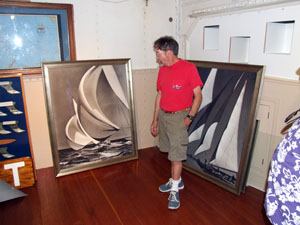 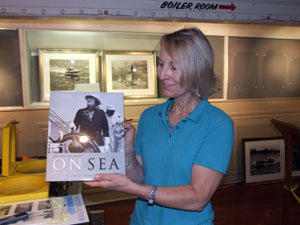
Ed Jones and Maggie’s husband Ted Walton were helping to mount the Rosenfeld collection on Monday, July 14, to have it ready for a special book signing and preview presentation July 23 by Stanley’s daughter-in-law Margaret Anderson Rosenfeld.
Telling a story that one imagines Berman would have loved to hear, Jones recalled how in 1992, during the America’s Cup races in San Diego, he had the privilege of skippering a 28-foot Bayliner on which Stanley Rosenfeld himself, then in his late 70’s, was one of four photographers on the first day out.
“We had to coordinate closely together because he would say ‘I need to be down-sun’ or ‘up-sun,’ and we couldn’t lay any wake on the boats, and we had to stay out of the way and follow these rules,” Jones related, relishing the memory. “He liked the way I did it, and afterwards he said, ‘I’m going to keep going out on your boat,’ and I said ‘great.’ And when the other photographers found out that Stanley was going to go on my boat, they all wanted to be with the great Stanley. It was like a badge of honor to be on the same boat with Stanley Rosenfeld. So we had Paris Match, Sports Illustrated, Associated Press, Los Angeles Times… all these photographers fighting to go on Stanley’s boat.”
The photo boats “had to go fast,” Jones said. “At the first leg you saw the boats out, and they went at 9 or 10 knots and you had to break off and go way off to one side (away from the race course) and get out and set up at the mark because you wanted to be there when they popped that spinnaker—that’s when disasters happened—so we would go racing around. We had to go 30 knots. And of course you are going over big swells and you are bouncing around like in a cigarette boat, and you don’t do it sitting down, because if you do you hurt your back. So you stand up and hold onto something, and as the boat goes up and down you go up and down like a jockey. You take the shock with your knees.”
Through all this, Stanley Rosenfeld remained “a sweet old guy, you would never know that he was famous. He was just a nice old guy, soft spoken. He would say ‘do you think we could get a shot up-sun? ‘ And we would say, ‘okay Stanley, whatever you want, you’ve got.’”
Jones said watching Rosenfeld work, he learned to understand how much preparation a good photographer needs in knowing exactly how the sun will strike its subject. “You come up to the windward mark, and you want the light on their faces, on what they’re doing,” Jones said. “But on the other hand, let us say they are coming down wind, and the spinnaker is up. You could be on the down side, when the light is coming through the spinnaker, backlighting it. That was hard to do, you didn’t want to get in front of them and lay a wake on them, so to get a shot like that was tricky. But those were the kinds of things that he instinctively understood, and I didn’t.”
What a way to watch a race! While most spectators wait near the starting line for the sailing vessels to come back, the photo boats tear along a parallel course on the ocean, then cut over at a safe distance beyond the mark to get into position. “Most of the photographers had at least two cameras, and they ran through a lot of film. They had motor drives, and they would rip off a roll as they rounded the turn, then sit that camera down, take out another camera, and then rip off another 35 shots!”
Those were the days before digital cameras, when film had to be processed and negatives painstakingly examined in order to find just the right shot to be sent by the photographers back to their publications.
“Flying Spinnakers” is an iconic photograph of an old sailing ship—taken in 1938—that Jones just loves and which will be the featured photograph of the Rosenfeld exhibit.
“It was a sensation at the time and it still is a sensation because I personally think of all the iconic photographs I have seen, this is the best ever. It received rave reviews when it came out—I’m pretty sure it was in Life Magazine. Everything about it is perfect. The composition is perfect. The photo boat is in exactly the right position, the sun angle is just right. He has the shadows and the light together to make a stunning image.”
Ted Walton, a commercial photographer, said what many people may not realize is the process that the Rosenfelds used was platinum palladium photography—those large images were printed from negatives that were just as large. The negatives were created by gradually regenerating the film. “I’m guessing these were all shot with a 4 x 5 camera, then reshot onto a negative, and then they paint the emulsion on,” Ted Walton said.
“That produced an image that will last 1,000 years—the paper will fall apart before the image deteriorates because the chemicals are metals. They are going to stay there. It is a wonderful process, but very time-consuming.”
Not only were the Rosenfeld images technically proficient, and chemically painstaking, said Ted Walton, but “they caught the golden age of sail. You won’t see the same boats sailing in races today.”
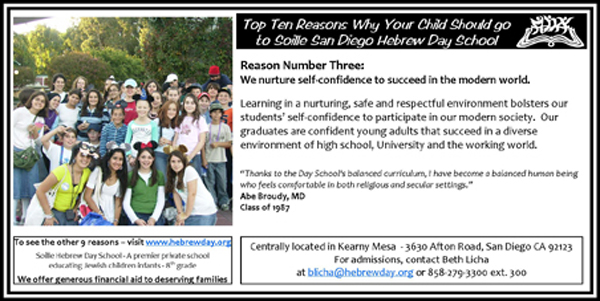

LETTERS
When a community works in concert
Editor, San Diego Jewish World
I would like to thank you for the fine article in San Diego Jewish World, where you gave a warm and informative account of our orchestra’s Pops Concert at the Allied Gardens Recreation Park yesterday. This is the fourth year that the Tifereth Israel Community Orchestra has presented these outdoor family concerts, and the attendance has continued to grow from year to year; the organizers of the event told me that around 1500 people were present on July 13.
The continued momentum and popular acceptance that these programs are generating not only point to the fact that everyone present “had a good time”, but to the concept that programs such as this one bonds a community, and people come together to bring a little closer the geographic area, in this instance, of Allied Gardens. The benefits generated by a synagogue orchestra, presenting a secular program with people of all faiths to people of all faiths speak for themselves.
I would like to thank the organizers and promoters, Jay Wilson representing Jim Madaffer and the San Diego City Council, the event coordinator, Don Brennan, who made it all happen so smoothly and professionally, and the TICO Committee and in particular Judy Gumbiner for all the detail work and enthusiastic support for our unique orchestra.
Please remind your readers of our next Pops Concert, on Sunday, July 27, 3:00 p.m., at Tifereth Israel Synagogue. Many of the same tunes from last night will be repeated, but with guest Pops Conductor Shelly Cohen, who for decades was the assistant conductor to Doc Severinsen in the Tonight Show Orchestra with Johnny Carson. The TICO Vocal Quartet, consisting of Sylvia Hartman, Victoria Robertson, Garrett Harris and Joe Pechota will sing many pops favorites, including Sabbath Prayer, from “Fiddler on the Roof” For more information, call (619) 607 6001.
David Amos
Conductor, Tifereth Israel Community Orchestra
San Diego, California
G.I Joe and biblical translation
Editor, San Diego Jewish World
Re: Sheila Orysiek’s “G. I. Joe’s choices reshape the battlefield," July 13th edition:
Clever. Learned. To the point. Thanks for the enlightenment. Isn't it ‘Thou shall not murder?’
Dan Schaffer
San Diego
Sheila Orysiek replies: “Dan, Dan, Dan: “Oh ye of little faith....seriously.....depends upon the
version/translation you read. This site lists interesting possibilities and uses the word ‘kill’ as do several other sites. http://www.religioustolerance.org/chr_10c4.htm I personally prefer the word "kill" because it includes stepping on an insect that I could otherwise avoid killing. We don't usually speak of stepping on a spider as "murder" - but it is needless killing."
Our growing arts and culture district
Editor, San Diego Jewish World
Everyone at the NTC Foundation was so pleased to see your article about our newest Resident Group at NTC Promenade – the New Americans Museum. The thread of stories you captured as you visited the Museum as well as some of our other galleries was remarkable and very enlightening. We appreciate your story and I hope it encourages many others to visit our growing Arts and Culture District.
Alan Ziter
Executive Director
NTC Foundation
San Diego, California




ADVENTURES IN SAN DIEGO JEWISH HISTORY
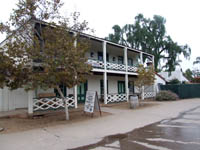
Robinson-Rose House
|
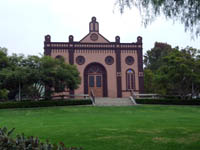
Old Temple Beth Israel |
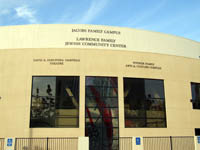
Lawrence Family JCC |
Editor's Note: We are reprinting news articles that appeared in back issues of various San Diego Jewish newspapers. You may access an index of the headlines of those articles by clicking here. You may also use the Google search program on our home page or on the headline index page to search for keywords or names.
Birdie Stodel B.B.
From Southwestern Jewish Press, July 24, 1947, page 6
Webster never invented the right sensational word to describe the very successful luncheon enjoyed by over 100 local women at the Chi-Chi Restaurant July 16th. Co-Chairmen Martha Feiler and Selma Lindenfeld should indeed be complimented on the wonderful manner in which they handled all plans. Mrs. Dorothy Weiner presented the Auxiliary with a most generous and thereby launched an avalanche of generous contributions, all toward the Child Rescue Fund of the Auxiliary. Notwithstanding the fact that a highly successful amount was realized from the luncheon, all guests commented on the social success of the afternoon. It is sincerely hoped that the community will continue to cooperate in such a spirited manner. Thanks and appreciation are due to all who attended.
The main business at hand now is the Breakfast Party to be held on August 3rd at 9:3 a.m., at the U.S. Grant Hotel. Honored guests of the day will be Mesdames Frieda Lavine, 2nd Vice President of B’nai B’rith women’s District No. 4, Grand Lodge, and Sylvia Vener, Past Grand President, and Birdie Stodel, Auxiliary’s Chapter Regional Deputy for the coming year. This breakfast meeting has been called at the request of Mrs. Lavine and she has also requested that no one attend except Birdie Stodel Auxiliary members so that the time may be utilized as a “workshop period.” All officers and members are urged to attend and set this date aside. There will be a nominal charge for breakfast and all attending are also invited to a Lasker Lodge-Birdie Stodel no-host luncheon to follow the meeting at Imig Manor, at 1:00 p.m. This day is a MUST on the B’nai B’rith calendar and it is hoped that a record number of members will attend to take advantage of such a meeting with these two Grand Lodge Officers.
The boat ride being held Saturday evening promises to be a social highlight of the scheduled Council meeting, and members can make reservations with Mrs. Esther Schwartz at J-8447. Reservations close at noon August 1st.
Congratulations are due to Mr. and Mrs. Alfred Breslauer and Mrs. J. G (?) Gruenberg upon the engagement of Joan Breslauer to Neil Gruenberg. In honor of the happy occasion, both mothers served cake and wine at the last regular meeting of the Auxiliary. Rabbi Baruch Stern, guest speaker at the meeting, preceded the serving of refreshments with a short prayer for the betrothed couple.
Yo-Ma-Co
From Southwestern Jewish Press, July 24, 1947, page 6
Four determined members faced a large gathering to present their facts and debate on a most timely subject: “Resolved—that terroristic activities in Palestine are furthering the aims of Zionism.” Jack Fine and Ray Lowitz represented the affirmative, while Dave Weissman and Jack Sterns handled the negative side. The debators battled back and forth as each voice their opinions, which kept the audience deeply interested. Many questions and answers followed this discussion with the final open vote favoring the affirmative side of this issue. Both teams performed exceptionally well to the satisfaction of a most enthused turnout.
Last Saturday night at Mission Beach, the Yo-Ma-Co’s held a most elegant weenie bake with all its trimmings and which included a treat given by the Henry Goldys in the form of delicious barbecued beef. Lively games of fun, topped by a tug-of-war for prizes and community singing concluded a grand time for all.
Everyone is still raving about the swell musical show presented by the talented members at the last installation. Could it be possible that it will instigate a club musical entertainment in the near future?
For the past six months your reporter has been avid Cohen who has furnished gossip and highlights of the club’s activities diligently. Dave hopes that his successor, unnamed as yet, will enjoy the work as much as he has.
Pioneer Women
From Southwestern Jewish Press, July 24, 1947
Before the great holocaust, the Moatzoath Hapoaloth (Working Women’s Council in Palestine) had a clear cut program for assisting in rebuilding Palestine, a Jewish Homeland. It was a program that included the founding of training schools for girls, building a network of nurseries and kindergartens, educating and caring for the children of working mothers and many other related projects. Since then, Moatzoath Hapoaloth has had to assume a great share of not only assisting with the salvaging of those of our people left in Europe but absorbing the new immigrants into the economic, social and cultural life of Palestine.
Their work embraces caring for women, youth and children before their legal entry which includes infant and maternity care, recreation and schooling for children and limited vocational training. Their housing program in the Palestine settlements must be accelerated to provide the necessary shelter after the immigrant’s eventual entry. Thousands await their turns to enter Jewish Palestine and the communities must be prepared to absorb them quickly.
This brief picture of the important program of Moatzoath Hapoaloth should give every Chaera the feeling of responsibility and price in contributing their individual share which means participation in the “Donor Dinner” on August 10th. There is still time to reserve your place and since the affair will be held on Sunday, husbands are welcome too. All proceeds go toward meeting the organization’s Moatzoath Hapoaloth quota.
A special meeting of the Pioneer Women will be held on Tuesday, July 29th, at Beth Jacob Center, for the purpose of collecting all outstanding monies for the Donor Dinner. All members are urged to attend and bring any tickets and money they have as yet not turned in. A non-profit luncheon will precede the business of the day.
Temple Sisterhood Project Off To Fine Start
From Southwestern Jewish Press, July 24, 1947, page 6
The newest project of the Temple Beth Israel Sisterhood, the sewing of layettes forbabies in the Displaced Persons Camp, is progressing will, according to Mrs. Estelle B. Levi, Sisterhood president. The ladies meet every Wednesday from 10:00 a.m. and sew until 3:00 p.m. at Red Cross Headquarters in Balboa Park.
With the increasing birthrate in these Camps, the need for layettes in larger numbers is vital, therefore the Sisterhood invites any lady with an aptitude for sewing to take part in this important project. The committee brings to attention the fact that the program is an all-week program, in that the work can be done at home. Any person who cannot get to sewing headquarters on Wednesday, is asked to stop ther to pick materials up that can be taken home.
Ladies! Organize a sewing club! Invite your friends to spend a few hours a week in a project so much needed.
The Sisterhood reminds readers that the collection of clothes for the S.O.S. is still being maintained and that clothes may be left in the garage of the Hebrew Home for the Aged, 2750 Fourth Avenue. The members of the Sisterhood sort, label and pack these garments for shipment to Europe. Mrs. Levi reports that they are almost ready to pack another shipment, and urges everyone to clean out those closets now and bring your good, used, not needed clothes to the Collection Depot without delay.

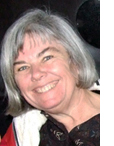 Nancy Harrison Nancy Harrison
cruise & tour specialist
(619) 265-0808

SAN DIEGO JEWISH WORLD THE WEEK IN REVIEW
Middle East
Israel's national guessing game: Can Olmert last? If not, who will succeed him? by Ira Sharkansy in Jerusalem
Sha'ar Hanegev bureau chief campaigns to dispose of litter at Kibbutz Ruhama by Ulla Hadar in Kibbutz Ruhama, Israel
Letters
Seeks memoirs from North Americans who volunteered during Israel's Six-Day War from Michael Zimmerman in Chicago
Yesawich, Rhodes make aliyah from San Diego from Dena Wimpfheimer in New York City
Article on Merchant Marine wins plaudits from Cantor Sheldon Merel in San Diego
Adventures in San Diego Jewish History
—July 24, 1947: Week At Camp In Palomar Mountain
—July 24, 1947: Day Camp Proves Successful in S.D.
—July 24, 1947: USO-JWB Enjoys ‘Brunch’
—July 24, 1947: Lasker Lodge B.B.
Arts
TICO concert brings community together by Donald H. Harrison in San Diego
Jean Isaacs: Generous spirit opens doors by Sheila Orysiek in San Diego
Middle East
Iran's bad week: gas deal with French Total sours, missile test lacks credibility by Shoshana Bryen in Washington, D.C.
Shaliach tells fellow kibbutzniks about his goodwill assignment in Tulsa, Oklahoma by Ulla Hadar in Kibbutz Ruhama, Israel
G. I. Joe’s choices reshape the battlefield by Sheila Orysiek in San Diego
San Diego and the Nation
World War II-era Merchant Mariners seek compensation for lost G.I. Bill privileges by Donald H. Harrison in San Diego
Adventures in San Diego Jewish History
—July 17, 1947: Lasker Lodge B.B.
—July 17, 1947: Jewish Labor Com.
—July 17, 1947: Birdie Stodel B.B.
—July 17, 1947: Pioneer Women
Judaism
The wily machinations of the yetzer hara by Rabbi Baruch Lederman in San Diego
Sports
A bissel sports trivia with Bruce Lowitt in Clearwater, Florida
Judaism
We can judge a leader by his followers by Rabbi Leonard Rosenthal in San Diego
San Diego
Danny and Clyde... They lived a lot, and stayed friends since their school days by Donald H. Harrison in San Diego
Adventures in San Diego Jewish History
—July 10, 1947: J.C.R.A
—July 10, 1947: Birdie Stodel B.B.
—July 10, 1947: U.S.O.-J.W.B. Activities
—July 17, 1947: Palomar Camp Plans Completed
Arts
Falstaff a great fall guy in 'Merry Wives' by Carol Davis in San Diego
Famed director Sydney Pollack laughingly agreed to take direction from an amateur by George Falkowitz in Oceanside, California
Chapter 16 of Reluctant Martyr, a serialized novel by Sheila Orysiek in San Diego
Middle East
Negev mayors protest Olmert decision against fortifications along Gaza border by Ulla Hadar in Sderot, Israel
U.S.-Iraq withdrawal negotiations prompt posturing for both countries' electorates by Shoshana Bryen in Washington D.C.
San Diego
San Diego had his dream job and great weather, but Israel had his heart by Donald H. Harrison in San Diego
San Diego Jewish Trivia: Places by Evelyn Kooperman in San Diego
Adventures in San Diego Jewish History
—July 10, 1947: Fund Total Must Be Raised
—July 10, 1947: Registration Opened for Camp Palomar
—July 10, 1947: 'Campers' to Visit Training Center
—July 10, 1947: Lasker Lodge B.B.
Arts
Globe's Romeo and Juliet needs polish by Carol Davis in San Diego
Thursdays with the Songs of Hal Wingard of San Diego
—#51, Waiting for Anne Marie
—#42, Magdalena
—#184, Anne
Middle East
'Gabriel's Revelation' may alter Jewish, Christian concepts of interrelationships by Ira Sharkansky in Jerusalem
Australia
A Roundup of Jewish news in Australia by Garry Fabian in Melbourne
—My grandson's bar mitzvah—and mine
—Shtetl of Zhetl inspires prize-winning essay
—Rabbi Yitzchok Groner dies aged 83
—Jewish groups avoid Diaspora study
—Rabbis oppose euthanasia bill
—Community looks closely at Jewish education cost
—Foreign Affairs Dept. investigates tourist's fate
—Bug's scientific name honors Australian Jew
—Australians to lead at Yad Vashem conference
—Achiever off to Prague
—JLC gets a new home
—Maccabi's winning run continues
—Police called after spiteful football game
San Diego
Scholarly, easy-to-read work tells of San Diego places people are dying to get into by Donald H. Harrison
Adventures in San Diego Jewish History
—July 3, 1947: Jewish Labor Com
—July 3, 1947: Birdie Stodel B.B.
—July 3, 1947: Yo-Ma-Co
—July 3, 1947: Pioneer Women
Arts
All that ends well still can be a problem by Carol Davis in San Diego
Sports
Two Jews in starting All-Star Game lineup by Bruce Lowitt in Clearwater, Florida
Middle East
The cause of freedom, then and now by Shoshana Bryen in Washington, D.C.
Volunteers psychologically counsel people, repair houses in rocket-scarred regionby Ulla Hadar in Kibbutz Ruhama, Israel
San Diego
New Americans Museum celebrates some of this country's richest blessings by Donald H. Harrison in San Diego
Adventures in San Diego Jewish History
—July 3, 1947: Palomar Camp Will Be Site Of Outdoor Activities
—July 3, 1947: Representatives of Agencies Meet in Temple
—July 3, 1947: Day Camp is Popular For Many Children
—July 3, 1947: San Diego Prepares For Post-USO
Arts
Two Yiddish books to tickle the silly bone by Sheila Orysiek in San Diego
Link to previous editions
< BACK TO TOP
|
|


